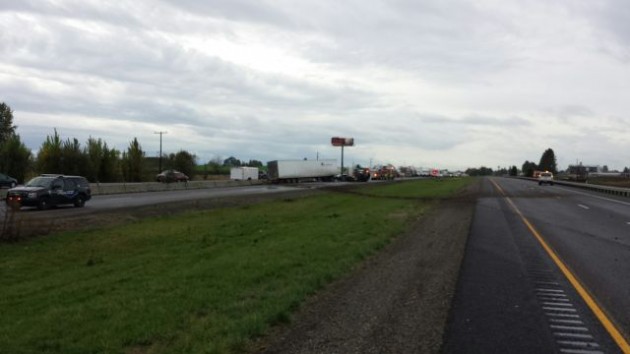It was in October 2012, almost exactly two years ago, that I wrote in my newly launched blog about ODOT installing a $2.6 milllion cable barrier in the median along 35 miles of I-5 in Lane and Linn counties, up to the Harrisburg exit. And I complained that while the state planned to extend this safety feature northward, we would have to wait until 2016-18 for this to be done.
Now, the latest fatal crossover crashes seem to have persuaded state officials that waiting is no longer an option. Friday afternoon, ODOT announced that Gov. Kitzhaber, “in consultation with ODOT Director Matthew Garrett, today called for ODOT to expedite plans to install cable barriers on sections of Interstate 5’s median between Salem to Albany in a project designed to reduce the number of crossover freeway crashes.” ODOT said it had been planning to call for bids as early as next February. “But after consulting with the governor, the department decided to implement an emergency procurement process and now expects to complete the work much sooner.”
The department referred to two fatal crossover crashes, the most recent just north of Albany on Thursday, which followed one on Sept. 24 in Salem that killed two State Hospital professionals, one of them the husband of a Portland city commissioner.
ODOT said it would activate an emergency process to negotiate a contract for the median barrier. Next week, the agency will contact contractors that have built cable barriers for the department before. It expects bids by the end of the week and hopes to pick a contractor by Nov. 5. Construction should start in mid-November.
It is sad that it took additional deaths and what sounds like an order from the governor to get ODOT to set aside its normally long time lines, but it will be good to see this barrier finally being installed. ODOT points out, though, that barriers don’t prevent all accidents. They just make it less likely for a loss of control on the freeway to result in a head-on collision in the opposite lanes.
ODOT made a point of citing the governor’s urging in its decision to install the barrier from Albany to Salem on an emergency basis. Normally Kitzhaber subjects issues to long studies. Perhaps he acted decisively in this case because Election Day is only a few days away. If so, we are seeing the benefits of a healthy competition for votes. (hh)



The cynic in me wonders why it takes an “emergency” to get government to do something in a reasonable time frame. I understand there will always be priorities but I sometimes question if they are arranged in an order that best serves the public safety, particularly in this case. Why does it often take tragedy to spur action?.
As for that mound of dirt median in the Salem area, I could hardly imagine a better launch pad for vehicles “crossing over” to the opposing lanes of traffic. The mound effectively shields light from oncoming headlights at night, which is a good thing, but God help you if you should hydroplane out of control into the median and that mound, given the short span between the north and southbound lanes of I-5 there. I’d much rather be constrained by the cable (or jersey) barrier than collide head on with opposing traffic.
When travelling on I-5 I find myself routinely checking the traffic going the opposite direction as a part of my defensive driving strategy because of the “crossover” possibility. That “mound median” in Salem effectively prevents any chance of evasive maneuvers should you find yourself on a collision course with an errant vehicle, suddenly airborne and aimed to collide with your vehicle. That “mound” just compounds what amounts to a very bad day for anyone in that situation or in their path.
One other thought. I suspect many of these “crossover” collisions are a result of a loss of control due to hydroplaning. Hydroplaning could be reduced by banning studded snow tires that accelerate the road wear that allows water to puddle, thus creating the condition where hydroplaning is most likely to occur.
I have spent much time and driven many thousands of miles in “snow country” and except in extremely rare conditions, I see no value in studs. A good snow tire will do just as well in any snow condition. The only time studs enhance traction are on ice, or snow hard enough to prevent indentation of the surface from the tread design. “Siping” has been found to be just as effective on very hard packed snow. Siping also reduces hydroplaning to a degree. The only time studs are an advantage (in my own experience) is on extremely hard ice, or ice with a thin film of water on the surface, such as a freezing rain event.
I also would note that during the 1980’s, Mt. Bachelor Inc. had a large fleet of vehicles that transported most of their employees to work on the mountain from Bend, a distance of about 20 miles each way. This fleet included everything from large busses to Subaru wagons and everything in between. Not one of those vehicles was equipped with studs.
Studs give many drivers a false sense of security in snow conditions. You have no idea how many accidents I saw because a driver thought their studs gave their cars the traction of a snow cat. I’ll bet they still don’t use studs at Mt. B. They would if there was an advantage.
I think studs should be banned. It is well documented how many dollars worth of damage they do to Oregon roads every year while providing such little benefit to the public. Just my $0.02 worth.